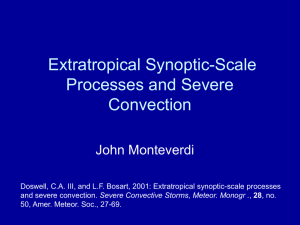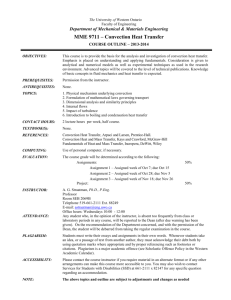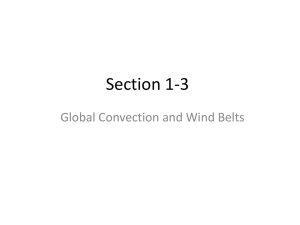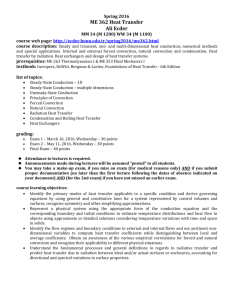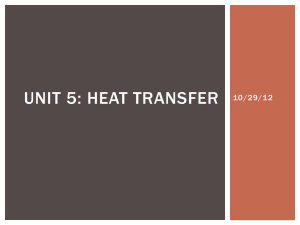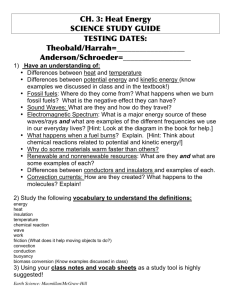JPM_Chapter2_Pt1
advertisement
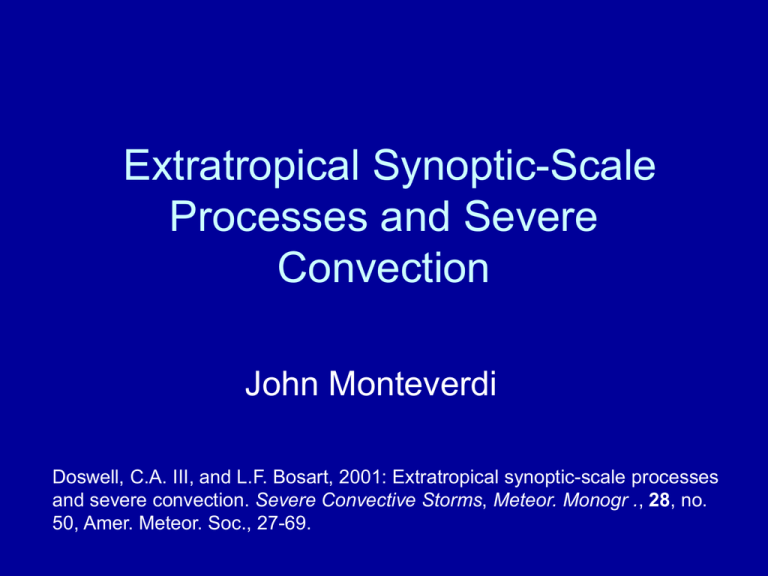
Extratropical Synoptic-Scale Processes and Severe Convection John Monteverdi Doswell, C.A. III, and L.F. Bosart, 2001: Extratropical synoptic-scale processes and severe convection. Severe Convective Storms, Meteor. Monogr ., 28, no. 50, Amer. Meteor. Soc., 27-69. Extratropical Synoptic-Scale Processes and Severe Convection • Introduction • Brief Overviews of Synoptic-scale and Subsynoptic Scale Processes – Quasigeostrophic Principles – Upper Level Jet Streak Dynamics End of First Part • Vertical Wind Shear • Planetary Boundary Layer Processes – Eckman Theory – Diurnal and Baroclinic Effects Introduction • Traditional view says synoptic-scale processes simply provide setting for severe convection, and that convection does not have an impact on the synoptic scale • Traditional view is that the mesoscale provides the source of parcel lift or local destabilization at the convective scale • Current view is that there are feedbacks between the synoptic-scale, high end mesoscale (aka subsynoptic) and the convective (low end mesoscale) scales. Introduction • What needs to be kept in mind is that nature does not really know these rigid definitions of scale • There are considerable interactions between the scales • Compartmentalizing the discussion on the bases of these scales is still useful. Brief Overviews of Synoptic-scale and Subsynoptic Scale Processes Quasigeostrophic Principles • Deep, moist convection (DMC) requires three ingredients – Moisture – Low Static Stability – Ascent of parcels to LFC • Extratropical cyclones (ETC) play role in first two, but, by definition, do not provide parcel lift • ETC provide the environment favoring the formation/development of mesoscale processes (e.g. related to drylines, fronts etc.) Brief Overviews of Synoptic-scale and Subsynoptic Scale Processes Quasigeostrophic Principles • The synoptic-scale vertical motion and pressure fields associated with ETC can be diagnosed and understood on the basis of quasigeostrophic (QG) theory – The QG-height tendency equation can be used to understand the development of pressure fields – The QG-omega equation can be used to diagnose the vertical motion fields The Relation of QG-Theory to Understanding the Synoptic Scale Environments of Severe Convection • The value of these equations is not really in the prediction, but qualitative understanding of midlatitude, synoptic-scale processes associated with ETC • Great effort is made by Doswell and Bosart to explore the importance of the static stability parameter The Relation of QG-Theory to Understanding the Synoptic Scale Environments of Severe Convection • is assumed to be a constant, which introduces error (why?) • Rising motion favors decrease in stability and sinking motion increases stability (why?) • Emanuel et al (1987) parameterizations, show that ascent is localized and intense, while descent is weaker and widespread and this is due to the first assumption above, which is erroneous (why?) • Static stability is important in formation of ETC (why?) Jet Streaks • Conceptual model used to diagnose ascent areas • Ascent favorable for cyclogenesis and organized DMC • Jet streaks often coupled to low level jet streams, advecting moist, unstable air Figure 2 Vertical Wind Shear • Important factor is determining severity of convection • Geostrophic vertical wind shear associated with thermal advection • Strong vertical wind shear is major factor in supercell convection Vertical Wind Shear • Strong vertical wind shear has been viewed as inhibiting factor for convection, as it tends to reduce intensity of updrafts • Actually promotes new cell development by interaction of existing updrafts and shear • For synoptically-evident, major outbreaks favorable wind shear widespread • But wind shear parameters vary substantially in synoptic scales • End of Part 1 Upper Level Jet Streaks • Jet streams have along-flow variation in wind speed that cannot be only curvature effects, called jet streaks Planetary Boundary Layer • Defined as the tropospheric layer where the effects of the surface are important • PBL not synoptic because time scale of processes as small as an hour or less • Still interacts with synoptic-scale systems Diurnal Variations in PBL • On sunny days, PBL has inversion that ascends and weakens • The erosion of the stable layer is one reason why DMC usually begins in afternoon • Movement of well-mixed, dry layer over a cooler layer can create capping inversion, suppressing convection • Capping can promote convection elsewhere by “storing” parcels with high CAPE Diurnal Variation in PBL • Decoupling of surface and atmosphere creates nocturnal boundary layer wind maximum, especially on sunny days • Diurnal cycle in horizontal temperature gradient, makes for poleward flow increasing with height at night • Combo of both makes low-level jet stream • Diurnal changes in PBL wind profile can modify potential for severe convection
